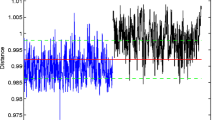Abstract
Automatic target recognition (ATR) is an important function for modern radar. High resolution range profile (HRRP) of target contains target structure signatures, such as target size, scatterer distribution, etc., which is a promising signature for ATR. Statistical modeling of target HRRPs is the key stage for HRRP statistical recognition, including model selection and parameter estimation. For statistical recognition algorithms, it is generally assumed that the test samples follow the same distribution model as that of the training data. Since the signal-to-noise ratio (SNR) of the received HRRP is a function of target distance, the assumption may be not met in practice. In this paper, we present a robust method for HRRP statistical recognition when SNR of test HRRP is lower than that of training samples. The noise is assumed independent Gaussian distributed, while HRRP is modeled by probabilistic principal component analysis (PPCA) model. Simulated experiments based on measured data show the effectiveness of the proposed method.
Similar content being viewed by others
References
Webb A R. Gamma mixture models for target recognition. Pattern Recognition, 2000, 33(12): 2045–2054
Copsey K, Webb A R. Bayesian Gamma mixture model approach to radar target recognition. IEEE Transactions on Aerospace and Electronic Systems, 2003, 39(4): 1201–1217
Du L, Liu H W, Bao Z, Zhang J Y. A two-distribution compounded statistical model for radar HRRP target recognition. IEEE Transactions on Signal Processing, 2006, 54(6): 2226–2238
Du L, Liu H W, Bao Z. Radar HRRP statistical recognition based on hypersphere model. Signal Processing, 2008, 88(5): 1176–1190
Du L, Liu H W, Bao Z. Radar HRRP statistical recognition: Parametric model and model selection. IEEE Transactions on Signal Processing, 2008, 56(5): 1931–1944
Shi L, Wang P H, Liu H W, Xu L, Bao Z. Radar HRRP statistical recognition with local factor analysis by automatic Bayesian Ying-Yang harmony learning. IEEE Transactions on Signal Processing, 2011, 59(2): 610–617
Wang P H, Shi L, Du L, Liu H W, Xu L, Bao Z. Radar HRRP statistical recognition with temporal factor analysis by automatic Bayesian Ying-Yang harmony learning. Frontiers of Electrical and Electronic Engineering in China, 2011, 6(2): 300–317
Xu L, Krzyzak A, Oja E. Rival penalized competitive learning for clustering analysis, RBF net, and curve detection. IEEE Transactions on Neural Networks, 1993, 4(4): 636–649
Xu L. Bayesian Ying-Yang system, best harmony learning and five action circling. Frontiers of Electrical and Electronic Engineering in China, 2010, 5(3): 281–328
Xu L. Bayesian Ying-Yang system and theory as a unified statistical learning approach: (V) Temporal modeling for temporal perception and control. Invited Paper. In: Proceedings of the International Conference on Neural Information Processing (ICONIP’98). 1998, 2: 877–884
Author information
Authors and Affiliations
Corresponding author
Additional information
Hongwei LIU received the B.Eng. degree from Dalian University of Technology, Dalian, China, in 1992; the M.Eng. and Ph.D degrees in electronic engineering from Xidian University, Xi’an, China, in 1995 and 1999, respectively. From 2001 to 2002, he was a visiting scholar with the Department of Electrical and Computer Engineering, Duke University, Durham, NC 27708, USA. He is currently a Professor and the Director of the National Laboratory of Radar Signal Processing, Xidian University. His research interests include radar automatic target recognition, netted radar, radar signal processing and detection, and adaptive signal processing.
Feng CHEN received the Ph.D. degree from Xidian University, Xi’an, China, in 2009. From 2009 to 2011, she was a postdoctoral at Shanghai Jiao Tong University, Shanghai, China. She is currently with the 8th Institute of Shanghai Academy of Space-flight Technology. Her research interests include radar automatic target recognition, remote sensing image analysis and interpretation.
Lan DU received the B.S., M.S., and Ph.D. degrees in electronic engineering from Xidian University, Xi’an, China, in Jul. 2001, Mar. 2004 and Jun. 2007, respectively. Her doctoral dissertation was granted Top 100 Doctoral Dissertation in China in 2009. From Sep. 2007 to Sep. 2009, she did research work as a Postdoctoral Research Associate in the Department of Electrical and Computer Engineering, Duke University, Durham, NC 27708, USA. She is currently a Professor in Xidian University. Her main research interests are in the fields of statistical signal processing and machine learning with application to radar target recognition.
Zheng BAO graduated from the Communication Engineering Institution of China, Xi’an, China, in 1953. Currently, he is a professor with Xidian University, Xi’an, China, and a member of the Chinese Academy of Sciences. He is the author or coauthor of six books and has published more than 300 papers. His research work focuses on the areas of space-time adaptive processing (STAP), radar imaging (SAR/ISAR), radar automatic target recognition (RATR), over-the-horizon radar (OTHR) signal processing and passive coherent location (PCL).
About this article
Cite this article
Liu, H., Chen, F., Du, L. et al. Robust radar automatic target recognition algorithm based on HRRP signature. Front. Electr. Electron. Eng. 7, 49–55 (2012). https://doi.org/10.1007/s11460-012-0191-1
Received:
Accepted:
Published:
Issue Date:
DOI: https://doi.org/10.1007/s11460-012-0191-1




